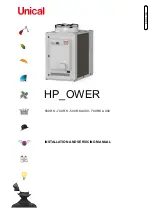
5
These pipes must be installed in a way that ensures that
people and property are not exposed to refrigerant leaks. As
the fluids can be diffused in the air, ensure that the outlet is
far away from any building air intake, or that they are
discharged in a quantity that is appropriate for a suitably
absorbing environment.
Periodic check of the relief valves: See chapter 1.3 -
“Maintenance safety considerations”.
Provide a drain in the drain pipe, close to each relief valve,
to avoid an accumulation of condensate or rain water.
All precautions concerning handling of refrigerant must be
observed in accordance with local regulations.
Ensure good ventilation, as accumulation of refrigerant in an
enclosed space can displace oxygen and cause asphyxiation
or explosions.
Inhalation of high concentrations of vapour is harmful and
may cause heart irregularities, unconsciousness, or death.
Vapour is heavier than air and reduces the amount of oxygen
available for breathing. These products cause eye and skin
irritation. Decomposition products are hazardous.
1.2 - Equipment and components under pressure
These products incorporate equipment or components under
pressure, manufactured by Carrier or other manufacturers. We
recommend that you consult your appropriate national trade
association or the owner of the equipment or components under
pressure (declaration, re-qualification, retesting, etc.). The
characteristics of this equipment/these components are given on
the nameplate or in the required documentation, supplied with the
products.
These units are intended to be stored and operated in an
environment where the ambient temperature must be not less
than the lowest allowable temperature indicated on the nameplate.
Do not introduce significant static or dynamic pressure with regard
to the operating pressures used during operation or for tests in
the refrigerant circuit or in the heat exchange circuits.
See section “11.2 - Pressure vessels”.
1.3 - Maintenance safety considerations
Carrier recommends the following drafting for a logbook (the table
below should not be considered as reference and does not involve
Carrier responsibility):
Intervention
Name of the
commissioning
engineer
Applicable
national
regulations
Verification
Organism
Date
Nature
(1)
(1) Maintenance, repairs, regular verifications (EN 378), leakage, etc.
Engineers working on the electric or refrigeration components
must be authorized, trained and fully qualified to do so.
All refrigerant circuit repairs must be carried out by a trained
person, fully qualified to work on these units. He must have been
trained and be familiar with the equipment and the installation. All
welding operations must be carried out by qualified specialists.
Any manipulation (opening or closing) of a shut-off valve must
be carried out by a qualified and authorised engineer. These
procedures must be carried out with the unit shut-down.
NOTE: The unit must never be left shut down with the liquid
line valve closed, as liquid refrigerant can be trapped between
this valve and the expansion device and lead to the risk of a
pressure increase. This valve is situated on the liquid line
before the filter drier box.
During any handling, maintenance and service operations
the engineers working on the unit must be equipped with
safety gloves, glasses, shoes and protective clothing.
Never work on a unit that is still energized.
Never work on any of the electrical components, until the
general power supply to the unit has been cut using the
disconnect switch(es) in the control box(es).
If any maintenance operations are carried out on the unit,
lock the power supply circuit in the open position ahead of
the machine.
If the work is interrupted, always ensure that all circuits are
still deenergized before resuming the work.
ATTENTION: Even if the unit has been switched off, the power
circuit remains energized, unless the unit or circuit disconnect
switch is open. Refer to the wiring diagram for further details.
Attach appropriate safety labels.
Units with option 231 are equipped with capacitor batteries
with a discharge time of five (5) minutes after disconnecting
the power. After disconnecting the power to the control box,
wait five minutes before opening the control box. Before any
intervention, verify that there is no voltage present at any
accessible conducting parts of the power circuit.
OPERATING CHECKS:
Important information regarding the refrigerant used:
-
This product contains fluorinated greenhouse gas
covered by the Kyoto protocol.
Fluid type: R134a
Global Warming Potential (GWP): 1430
CAUTION:
1. Any intervention on the refrigerant circuit of this product
should be performed in accordance with the applicable
legislation. In the EU, the regulation is called F-Gas,
N°517/2014
2. Ensure that the refrigerant is never released to the
atmosphere during installation, maintenance or equipment
disposal.
3. The deliberate gas release into the atmosphere is not
allowed.
4. If a refrigerant leak is detected, ensure that it is stopped
and repaired as quickly as possible.
5. Only a qualified and certified personnel can perform
installation operations, maintenance, refrigerant circuit
leak test as well as the equipment disposal and the
refrigerant recovering.
6. The gas recovery for recycling, regeneration or destruction
is at customer charge.
1 - INTRODUCTION
Summary of Contents for AquaForce 30XB series
Page 69: ......






































